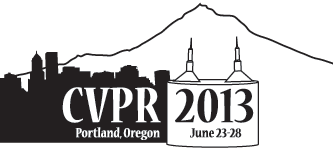-
Modeling Actions through State Changes
AbstractIn this paper we present a model of action based on the change in the state of the environment. Many actions involve similar dynamics and hand-object relationships, but differ in their purpose and meaning. The key to differentiating these actions is the ability to identify how they change the state of objects and materials in the environment. We propose a weakly supervised method for learning the object and material states that are necessary for recognizing daily actions. Once these state detectors are learned, we can apply them to input videos and pool their outputs to detect actions. We further demonstrate that our method can be used to segment discrete actions from a continuous video of an activity. Our results outperform state-of-the-art action recognition and activity segmentation results.
Related Material
[pdf][bibtex]@InProceedings{Fathi_2013_CVPR,
author = {Fathi, Alireza and Rehg, James M.},
title = {Modeling Actions through State Changes},
booktitle = {Proceedings of the IEEE Conference on Computer Vision and Pattern Recognition (CVPR)},
month = {June},
year = {2013}
}
These CVPR 2013 papers are the Open Access versions, provided by the Computer Vision Foundation.
Except for the watermark, they are identical to the accepted versions; the final published version of the proceedings is available on IEEE Xplore.
Except for the watermark, they are identical to the accepted versions; the final published version of the proceedings is available on IEEE Xplore.
This material is presented to ensure timely dissemination of scholarly and technical work.
Copyright and all rights therein are retained by authors or by other copyright holders.
All persons copying this information are expected to adhere to the terms and constraints invoked by each author's copyright.

